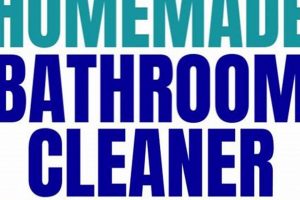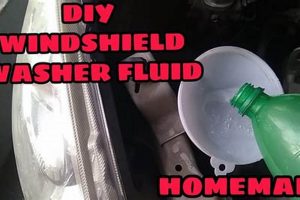A do-it-yourself lash enhancement procedure involves the application of chemical solutions to the eyelashes at home, aiming to lift and curl them. This process mimics professional salon treatments but is performed by the individual themselves, often utilizing kits purchased online or from beauty supply stores. For example, an individual might use a pre-packaged kit containing lifting cream, setting lotion, and silicone pads to achieve a curled lash effect without the need for a trained technician.
The appeal of self-administered lash lifting stems from its potential cost-effectiveness and convenience compared to salon appointments. Historically, eyelash enhancement primarily involved mascaras or false lashes. However, the introduction of at-home lifting kits offers a longer-lasting alternative, providing a semi-permanent curl. The importance of understanding the process lies in mitigating potential risks associated with improper product use or technique, and in ensuring a satisfactory aesthetic outcome.
The subsequent sections will delve into the specific components of at-home lash lifting kits, crucial safety precautions to consider before attempting the procedure, and detailed step-by-step instructions for achieving optimal results. Furthermore, potential risks and troubleshooting methods will be addressed to offer a comprehensive understanding of the entire process.
Essential Guidance for At-Home Lash Enhancement
Achieving satisfactory results with self-administered lash lifting requires careful attention to detail and adherence to best practices. The following tips offer practical guidance to minimize risk and maximize the potential for a successful outcome.
Tip 1: Patch Test Prior to Application: Conduct a patch test on a small area of skin, such as the inner arm, 48 hours before initiating the procedure. This identifies potential allergic reactions to the chemical solutions contained within the kit.
Tip 2: Meticulous Cleaning of Eyelashes: Thoroughly cleanse the eyelashes to remove any residual makeup, oils, or debris. Impurities can impede the efficacy of the lifting solutions and compromise the final result. Use an oil-free cleanser specifically designed for eye areas.
Tip 3: Precise Placement of Silicone Pads: Securely adhere the silicone pads to the eyelids, ensuring they are positioned as close to the lash line as possible. This step dictates the degree of lash lift achieved and minimizes the risk of solution contact with the skin.
Tip 4: Controlled Application of Lifting Solution: Apply the lifting solution precisely to the mid-section of the lashes, avoiding the roots and tips. Over-application or contact with the skin can cause irritation or damage.
Tip 5: Strict Adherence to Processing Times: Precisely follow the manufacturer’s recommended processing times for both the lifting and setting solutions. Over-processing can lead to lash damage, while under-processing results in a weak or ineffective lift.
Tip 6: Neutralization and Hydration Post-Treatment: After completing the procedure, thoroughly cleanse the lashes with a saline solution to neutralize any remaining chemicals. Apply a lash-nourishing serum or oil to hydrate and strengthen the lashes, mitigating potential dryness or brittleness.
Tip 7: Avoid Water and Steam Exposure: Refrain from exposing the lashes to water, steam, or harsh rubbing for the first 24-48 hours post-treatment. This allows the lift to fully set and prolongs the duration of the effect.
By adhering to these guidelines, individuals can enhance the safety and effectiveness of at-home lash lifting, maximizing the likelihood of achieving a desirable and long-lasting curl.
The concluding section will offer advice on troubleshooting potential problems and maintaining the results achieved through this method.
1. Solution Ingredient Awareness
Solution ingredient awareness is a fundamental aspect of safe and effective self-administered lash lifting. The procedure involves the application of chemical solutions to alter the structure of the eyelashes. Lack of understanding regarding these chemicals presents a significant risk of adverse reactions, ranging from mild irritation to severe allergic responses and potential damage to the eyelashes or surrounding skin. For example, a lifting solution with an excessively high pH can cause significant irritation or even chemical burns to the delicate skin around the eyes. Without prior knowledge of such properties, individuals might unknowingly expose themselves to these hazards.
The composition of lash lifting solutions typically includes ammonium thioglycolate, hydrogen peroxide, and other chemicals designed to break and reform disulfide bonds in the hair. A key component of ingredient awareness involves understanding the concentration of these active agents and their potential effects. Individuals should scrutinize ingredient lists, research the function of each component, and be cognizant of potential allergens. Consider an individual with a known allergy to sulfates. If unaware of the presence of sulfates in a particular lifting solution, an allergic reaction could ensue, leading to discomfort and potential medical intervention. This demonstrates that diligent ingredient assessment is not merely a precaution, but a necessity.
In conclusion, informed decision-making regarding self-administered lash lifting necessitates a thorough understanding of the chemical constituents within the solutions employed. Prioritizing solution ingredient awareness mitigates the risk of adverse reactions, promotes safer application practices, and ultimately contributes to more satisfactory and sustainable results. Challenges associated with this approach include deciphering complex chemical nomenclature and accessing reliable information about specific ingredients. However, the benefits of proactive research and careful product selection far outweigh the potential consequences of neglecting this crucial aspect of at-home lash enhancement.
2. Sanitation is Crucial
The principle of “Sanitation is Crucial” holds paramount importance within the domain of self-administered lash lifting procedures. The potential for adverse events, including infections and irritation, necessitates a rigorous adherence to hygienic practices throughout the process.
- Sterilization of Implements
Effective sterilization of all tools utilized during the lash lifting process, such as application brushes, silicone rods, and separation tools, is non-negotiable. Insufficient sterilization can introduce bacteria, fungi, or viruses to the periocular area, potentially leading to conjunctivitis, blepharitis, or, in rare instances, more severe ocular infections. For example, reusable tools that have not undergone appropriate autoclaving or chemical disinfection pose a significant contamination risk.
Hand Hygiene Practices Thorough hand washing with antimicrobial soap prior to initiating the procedure is a fundamental requirement. The hands serve as a primary vector for the transmission of pathogens. Failure to maintain adequate hand hygiene can transfer harmful microorganisms to the delicate skin surrounding the eyes, thereby increasing the probability of infection. Consider a scenario where an individual, without washing their hands, touches surfaces contaminated with bacteria and then proceeds to manipulate the lash lifting implements near their eyes; the risk of infection is substantially elevated.
- Single-Use Applicators
The utilization of single-use applicators, such as micro brushes and cotton swabs, is strongly recommended to minimize the risk of cross-contamination. Reusing applicators, even after cleaning, can harbor residual bacteria and chemicals, potentially leading to irritation or infection. The benefits of disposable applicators far outweigh the marginal cost savings associated with reusing them.
- Surface Disinfection
Disinfection of the work surface is an often overlooked aspect of sanitation within diy lash lift. The area where the procedure will be performed must be disinfected with an EPA-approved disinfectant. This is important to minimize the risk of exposure to outside contaminants.
In summation, the successful and safe execution of self-administered lash lifting hinges upon strict adherence to sanitation protocols. The implementation of effective sterilization techniques, rigorous hand hygiene practices, and the use of disposable applicators collectively contribute to minimizing the potential for infections and promoting a positive experience. Neglecting these measures can have detrimental consequences, potentially leading to ocular complications that necessitate medical intervention. The commitment to cleanliness is therefore inextricably linked to the overall success and safety of self-administered lash enhancements.
3. Precise Timing Matters
In the context of self-administered lash lifting, strict adherence to recommended processing times is critical. The chemical solutions employed in these kits induce a structural change in the eyelashes, and the duration of exposure directly correlates with the extent of this alteration. Under-processing yields negligible results, failing to achieve the desired lift and curl. Conversely, over-processing can compromise the integrity of the lashes, leading to weakening, brittleness, breakage, and even permanent damage. The delicate nature of eyelash hair necessitates meticulous control over the duration of chemical exposure. For instance, if a lifting solution is left on for five minutes longer than the instructed time, the disulfide bonds within the lash structure could be excessively broken, resulting in frizzy and damaged lashes post-treatment. Such errors underscore the imperative nature of precise timing.
The practical significance of understanding and implementing precise timing stems from the direct impact on both the aesthetic outcome and the health of the eyelashes. Manufacturers provide specific timeframes based on extensive testing and calibration to achieve optimal results while minimizing harm. Deviating from these recommendations introduces a substantial element of risk. An individual attempting lash lifting at home must use a reliable timer and monitor the process diligently. Moreover, factors such as lash thickness and strength can influence ideal processing times. Those with thinner or weaker lashes may need to slightly reduce the recommended exposure duration, while individuals with thicker, more resistant lashes might require the full recommended time. However, adjustments should be made cautiously and with a thorough understanding of potential consequences. This careful management ensures that the desired degree of lift is achieved without compromising lash health.
In summary, accurate timing is not merely a suggested step in the self-administered lash lifting process but a fundamental requirement for success and safety. While individual lash characteristics may warrant subtle adjustments, strict adherence to manufacturer guidelines and vigilant monitoring are essential. Failure to prioritize precise timing can lead to unsatisfactory aesthetic results and, more importantly, irreversible damage to the eyelashes. This underscores the importance of diligent execution and thorough comprehension of the chemical processes involved.
4. Pad Placement Accuracy
Pad placement accuracy is inextricably linked to the outcome of a self-administered lash lifting procedure. The position of the silicone pad on the eyelid directly influences the shape and degree of the resulting lash curl. Improper placement can lead to uneven lifting, distorted lash shapes, or even no discernible lift at all. For example, if the pad is positioned too far from the lash line, the lifting solution will not effectively reach the base of the lashes, resulting in a minimal curl. Conversely, a pad placed too close to the lash line can cause the lashes to bend sharply at the root, creating an unnatural and potentially damaging kink. Therefore, precise pad application serves as a critical control point in dictating the final aesthetic.
Consider the practical implications of this connection. An individual attempting self-administered lash lifting must possess a clear understanding of ideal pad positioning based on their specific eye shape and desired curl. Different eye shapes may require variations in pad size and placement to achieve symmetrical and balanced results. For instance, hooded eyelids may necessitate a higher pad placement to ensure the lashes are adequately lifted from beneath the fold of skin. Furthermore, proper adhesion of the pad to the eyelid is equally important. Gaps or air pockets between the pad and the skin can disrupt the lifting process and lead to inconsistent results. This underscores the importance of meticulous application and secure adherence for optimal outcomes.
In summary, pad placement accuracy represents a fundamental component of successful self-administered lash lifting. The position of the pad directly influences the shape, symmetry, and overall effectiveness of the procedure. Challenges associated with this step include variations in eye shape and the need for precise application techniques. However, a thorough understanding of these factors and a commitment to meticulous execution are essential for achieving the desired aesthetic outcome and minimizing the risk of unsatisfactory or damaging results. The accuracy of pad placement, therefore, is a primary determinant of the overall success of self-administered lash enhancement.
5. Skin Protection Imperative
Self-administered lash lifting entails the application of chemical solutions in close proximity to the delicate skin surrounding the eyes. The “Skin Protection Imperative” arises from the potential for these chemicals to cause irritation, allergic reactions, or even chemical burns. Direct contact between lifting or setting solutions and the skin can lead to immediate discomfort, redness, swelling, and, in more severe cases, blistering and scar
ring. For instance, ammonium thioglycolate, a common ingredient in lifting solutions, is a known irritant that can induce contact dermatitis if it comes into prolonged or concentrated contact with the skin. Therefore, safeguarding the skin during the procedure is not merely a precautionary measure but a critical element for preventing adverse events.
Effective skin protection strategies during at-home lash lifting revolve around creating a physical barrier between the chemical solutions and the skin. This is typically achieved through the application of a protective balm or petroleum jelly along the lash line and surrounding areas. This barrier acts as a buffer, preventing direct contact and minimizing the absorption of chemicals into the skin. Furthermore, precise application techniques, such as using small, controlled amounts of solution and avoiding spillage, contribute to reducing the risk of skin exposure. Consider an individual with sensitive skin attempting a lash lift without adequate skin protection. They are significantly more likely to experience adverse reactions compared to someone who diligently applies a protective barrier. Similarly, ensuring the eyelids are completely closed during the application process minimizes the risk of solution seeping into the eyes, which can cause severe irritation and potential damage.
In conclusion, the “Skin Protection Imperative” is a non-negotiable aspect of safe and successful self-administered lash lifting. Neglecting this crucial element significantly elevates the risk of adverse reactions, ranging from mild irritation to severe chemical burns. Employing effective barrier methods, practicing precise application techniques, and maintaining vigilance throughout the procedure are essential for safeguarding the delicate skin surrounding the eyes. Adherence to these principles not only promotes a more comfortable experience but also minimizes the potential for long-term damage. The success of at-home lash enhancement hinges, in part, on prioritizing skin health and safety.
6. Post-Treatment Care
The longevity and health of eyelashes following a self-administered lash lift are directly influenced by post-treatment care. The lifting process, by its nature, alters the structural integrity of the lash hair, rendering it temporarily more vulnerable to damage and dehydration. Neglecting proper aftercare can diminish the duration of the lift, compromise lash health, and potentially lead to breakage or weakening. For instance, exposure to harsh chemicals or excessive rubbing within the initial 24-48 hours post-procedure can disrupt the setting process and cause the newly lifted lashes to revert to their original shape prematurely.
Post-treatment care commonly encompasses several key elements, including the application of hydrating serums or oils specifically formulated for eyelashes. These products replenish moisture lost during the lifting process and help to strengthen the hair shaft, promoting resilience and preventing brittleness. Additionally, avoidance of oil-based makeup removers is crucial, as oils can break down the chemical bonds created during the lift, accelerating the reversion process. A real-world example demonstrates that consistent application of a lash-conditioning serum twice daily can extend the life of a diy lash lift by several weeks compared to neglecting such care. Proper sleep positioning, avoiding face-down sleeping, also contributes to maintaining the integrity of the lift.
In summary, diligent post-treatment care is an indispensable component of a successful self-administered lash lift. It directly affects the durability of the lift, maintains lash health, and mitigates potential damage. While the diy lash lift procedure itself initiates the aesthetic change, it is the subsequent care regimen that solidifies and sustains the results. Challenges may arise in maintaining consistency with the aftercare routine; however, understanding the cause-and-effect relationship between post-treatment actions and lash condition reinforces the importance of adhering to recommended practices. The long-term success of the at-home lash enhancement depends on a holistic approach encompassing both the procedure and its corresponding maintenance.
7. Realistic Expectations
The intersection of “Realistic Expectations” and the practice of self-administered lash lifting is pivotal for ensuring both satisfaction and safety. The allure of achieving salon-quality results at home can often overshadow the limitations inherent in a do-it-yourself approach. A mismatch between anticipated outcomes and actual results can lead to dissatisfaction, potential misuse of products, and increased risk of adverse reactions.
- Lash Condition and Potential
The natural state of an individual’s eyelashes significantly influences the achievable results. Those with short, sparse, or damaged lashes may not experience the same dramatic lift and curl as those with long, healthy lashes. For example, someone with very fine lashes should anticipate a subtle lift, rather than the pronounced curl often depicted in promotional materials. Acknowledging pre-existing lash conditions is essential for setting appropriate expectations.
- Skill Level and Technique
The effectiveness of a self-administered lash lift is directly proportional to the skill and precision applied during the process. Novices should not expect to achieve the same level of proficiency as experienced technicians. Subtle errors in pad placement, solution application, or timing can significantly impact the outcome. For instance, uneven pad placement can result in an asymmetrical lift, while improper solution application can lead to over-processing or under-processing of the lashes. Recognizing one’s skill limitations is crucial for managing expectations and mitigating potential errors.
- Product Limitations
At-home lash lifting kits are generally formulated with lower concentrations of active ingredients compared to professional salon products. This is intended to enhance safety and reduce the risk of adverse reactions, but it also limits the achievable degree of lift and curl. Expecting the same dramatic results from an at-home kit as from a professional treatment is unrealistic. Individuals must understand that at-home kits are designed for subtle enhancement, rather than dramatic transformation.
- Maintenance and Longevity
The duration and appearance of a diy lash lift are influenced by various factors, including lash growth cycle, aftercare practices, and individual lash characteristics. Results typically last between four to six weeks, and the lift gradually diminishes as new lashes grow in. Expecting the lift to remain perfectly intact for an extended period without proper maintenance is unrealistic. Consistent aftercare, such as using hydrating serums and avoiding harsh rubbing, can prolong the results, but the lift will inevitably fade over time.
In conclusion, establishing realistic expectations is paramount for a positive and safe experience with self-administered lash lifting. Understanding the limitations imposed by lash condition, skill level, product formulation, and maintenance requirements is essential for managing expectations and preventing dissatisfaction. By aligning expectations with achievable outcomes, individuals can minimize the risk of misuse, adverse reactions, and disappointment, thereby promoting a more i
nformed and responsible approach to at-home lash enhancement.
Frequently Asked Questions About DIY Lash Lift
This section addresses common inquiries regarding self-administered lash lifting procedures. The information provided aims to clarify misconceptions and offer guidance for informed decision-making.
Question 1: What are the primary risks associated with performing a diy lash lift?
The primary risks include chemical burns to the skin or cornea, allergic reactions to the lifting solutions, over-processing of the lashes leading to breakage, and infection due to unsanitary practices.
Question 2: How long do the results of a diy lash lift typically last?
The duration of the lift varies depending on individual lash growth cycles and aftercare practices but generally ranges from four to six weeks.
Question 3: Can a diy lash lift be performed on eyelashes that have been previously permed or treated?
Performing a self-administered lash lift on previously treated lashes is not recommended, as it can increase the risk of damage and over-processing. A waiting period of several weeks is advised.
Question 4: What are the essential sanitation measures to be taken when performing a diy lash lift?
Essential sanitation measures include sterilizing all tools, washing hands thoroughly with antimicrobial soap, using disposable applicators, and disinfecting the work surface.
Question 5: How can allergic reactions to the diy lash lift solutions be prevented?
Allergic reactions can be minimized by performing a patch test 48 hours before the procedure, carefully reviewing the ingredient list, and avoiding products with known allergens.
Question 6: What steps should be taken if the diy lash lift results in irritation or an adverse reaction?
If irritation or an adverse reaction occurs, the procedure should be stopped immediately. The eyes should be flushed with saline solution, and medical attention should be sought if symptoms persist or worsen.
These FAQs offer a concise overview of important considerations related to self-administered lash lifting. Prioritizing safety and informed decision-making is crucial for achieving satisfactory results.
The subsequent section will provide a summary of key takeaways and final thoughts regarding the practice of diy lash lift.
Conclusion
This exploration of diy lash lift procedures has underscored the inherent risks and rewards associated with at-home lash enhancement. A thorough understanding of chemical properties, sanitation protocols, and proper application techniques is paramount to mitigating potential adverse reactions. While the allure of cost-effectiveness and convenience is undeniable, the fragility of the ocular region necessitates a cautious and informed approach.
Individuals contemplating a diy lash lift must diligently weigh the potential benefits against the inherent risks. Further research and consultation with qualified professionals are strongly encouraged before engaging in this self-administered aesthetic practice. The responsible pursuit of beauty should always prioritize safety and well-being.





![DIY Build: Circular Saw Crosscut Jig PDF Plans [Free] The DIY Hub: Creative Crafts, Repairs & Life Hacks DIY Build: Circular Saw Crosscut Jig PDF Plans [Free] | The DIY Hub: Creative Crafts, Repairs & Life Hacks](https://craftingdiycenter.com/wp-content/uploads/2025/07/th-5916-300x200.jpg)

